An Enhanced SAR-Based ISW Detection Method Using YOLOv8 with an Anti-Interference Strategy and Repair Module and Its Applications
Abstract
Highlights
- This study proposes a robust, lightweight detection method built upon the YOLOv8 framework, integrating an anti-interference strategy and a post-processing repair module. This approach significantly enhances detection accuracy by reducing the false detection rate from 50.20% in the baseline model to 6.00% (a reduction of 44.20 percentage points) and effectively reconstructs 85.2% of broken wave crest lines.
- The application of this method to extensive SAR imagery reveals distinct spatio-temporal patterns of ISW activities in the Andaman Sea, Sulu Sea, and Celebes Sea, and identifies core activity areas in each region.
- At the technical application level, this study proposes an automatic detection method for internal solitary waves. This method, by introducing an anti-interference strategy and a post-processing repair module, enhances the recognition accuracy of identifying internal solitary waves from massive satellite remote sensing images, providing a new technical means for nearshore engineering safety, underwater navigation support, and marine physics research.
- At the level of marine science cognition, this method is utilized to conduct detailed observations on the spatio-temporal distribution of internal solitary waves in typical sea areas. Based on a systematic analysis of over four thousand satellite images, the study confirms some known active regions of internal solitary waves and reveals the characteristics of internal wave activities in different sea areas. These results enhance the understanding of the internal wave patterns in the relevant sea areas and provide support for subsequent research.
Abstract
1. Introduction
2. Materials
3. Methods
3.1. Model and Training Parameter Configuration
3.2. Post-Processing Repair Module
| Algorithm 1: Adaptive ISW Crest Line Reconstruction | |
| Input: Disconnected crest segments P, distance threshold , angle threshold Output: Reconstructed crest lines C | |
| 1 | for each segment do |
| 2 | ; // Minimum bounding rectangle |
| 3 | ; // Spindle direction |
| 4 | ; // Skeleton line |
| 5 | ; // Initialize connection graph |
| 6 | for each pair where do |
| 7 | ; |
| 8 | if then |
| 9 | with ; |
| 10 | ; // Initialize reconstructed lines |
| 11 | while do |
| 12 | ; |
| 13 | ; |
| 14 | for each do |
| 15 | ; |
| 16 | ; |
| 17 | Return ; |
4. Results and Discussion
4.1. Anti-Interference Performance of the Model
4.2. The Performance of the Post-Processing Repair Module
4.3. Application of the Detection Method
4.3.1. Spatial and Temporal Distribution Characteristics of ISWs in the Andaman Sea
4.3.2. Spatial and Temporal Distribution Characteristics of ISWs in the Sulu Sea and the Celebes Sea
5. Conclusions
Author Contributions
Funding
Data Availability Statement
Conflicts of Interest
References
- Meng, J.; Long, R.; Sun, L.; Zhang, H.; Cao, Z. Review of Research on Remote Sensing Detection of Internal Solitary Waves Based on Machine Learning. Digit. Ocean. Underw. Warf. 2024, 7, 2–8. [Google Scholar] [CrossRef]
- Yang, X.; Li, Z.; Zhao, Y.; Chong, J. Spatiotemporal Variation of Internal Solitary Waves in the Northern Bay of Biscay Based on Sequential SAR Images. IEEE Trans. Geosci. Remote Sens. 2025, 63, 5207014. [Google Scholar] [CrossRef]
- Yang, Z.; Wang, J.; Li, Z.; Lu, Y.; Huang, S.; Sun, L. Study on the Characteristics of Internal Solitary Waves in Arctic Kara Sea Based on SAR Images. IEEE Trans. Geosci. Remote Sens. 2024, 62, 4207113. [Google Scholar] [CrossRef]
- Li, Z.; Wang, J.; Chen, X.; Lu, K.; Chang, Z.; Lu, Y.; Wang, X. Observation of Mode-2 Internal Solitary Waves in the Northern South China Sea Based on Optical Remote Sensing. IEEE J. Sel. Top. Appl. Earth Obs. Remote Sens. 2024, 17, 11550–11562. [Google Scholar] [CrossRef]
- Zhong, J.; Zhou, X. Survey of Study on Internal Waves Detection in Synthetic Aperture Radar Image. J. Radars 2013, 2, 406–421. [Google Scholar] [CrossRef]
- Alpers, W. Theory of radar imaging of internal waves. Nature 1985, 314, 245–247. [Google Scholar] [CrossRef]
- Hogan, G.G.; Marsden, J.B.; Henry, J.C. On the Detection of Internal Waves in High-Resolution SAR Imagery Using the Rough Transform. In Proceedings of the OCEANS 91, Honolulu, HI, USA, 1–3 October 1991; pp. 1363–1369. [Google Scholar] [CrossRef]
- Rodenas, J.A.; Garello, R. Wavelet Analysis in SAR Ocean Image Profiles for Internal Wave Detection and Wavelength Estimation. IEEE Trans. Geosci. Remote Sens. 1997, 35, 933–945. [Google Scholar] [CrossRef]
- Rodenas, J.A.; Garello, R. Internal Wave Detection and Location in SAR Images Using Wavelet Transform. IEEE Trans. Geosci. Remote Sens. 1998, 36, 1494–1507. [Google Scholar] [CrossRef]
- Dokken, S.T.; Olsen, R.; Wahl, T.; Tantillo, M.V. Identification and Characterization of Internal Waves in SAR Images along the Coast of Norway. Geophys. Res. Lett. 2001, 28, 2803–2806. [Google Scholar] [CrossRef]
- Surampudi, S.; Sasanka, S. Internal Wave Detection and Characterization with SAR Data. In Proceedings of the 2019 IEEE Recent Advances in Geoscience and Remote Sensing: Technologies, Standards and Applications (TENGARSS), Kochi, India, 17–20 October 2019; pp. 104–108. [Google Scholar] [CrossRef]
- Xu, S.; Chen, J.; Li, T.; Tao, R. Automatic Feature Detection of Ocean Internal Wave SAR Image Based on Hierarchical Clustering. Comput. Sci. Appl. 2019, 9, 1118–1125. [Google Scholar] [CrossRef]
- Zheng, Y.; Zhang, H.; Li, X.; Zhang, Z. Detection Algorithm of Internal Waves in the South China Sea Based on Boundary Characteristics of Remote Sensing Image. J. Trop. Oceanogr. 2020, 39, 41–56. [Google Scholar]
- Sun, L.; Zhang, J.; Meng, J. Propagation Speed of Internal Waves in the Northern South China Sea Based on Remote Sensing and In Situ Observation Data. Oceanol. Limnol. Sin. 2018, 49, 471–480. [Google Scholar]
- Sun, L.; Zhang, J.; Meng, J.; Wang, J.; Zhang, X. Analysis of Internal Waves in the Japan Sea with Multi-Sensors Remote Data. Acta Oceanol. Sin. 2018, 40, 102–111. [Google Scholar] [CrossRef]
- Wang, J.; Yang, J.; Zhou, L.; He, S.; He, Z.; Xiao, Q.; Liu, A.; Xu, M. Distribution of Internal Waves in the Andaman Sea and Its Adjacent Waters Based on Multi-Satellite Remote Sensing Data. J. Mar. Sci. 2019, 37, 1–11. [Google Scholar] [CrossRef]
- Zhang, H.; Meng, J.; Sun, L. Research on Characteristic Parameter Distribution and Generation Period of Internal Waves in the Andaman Sea with MODIS. Acta Oceanol. Sin. 2020, 42, 110–118. [Google Scholar]
- Zhang, T.; Zhang, X. Characteristics on internal solitary waves in the Sulu-Celebes Sea based on MODIS and VIIRS remote sensing images. Oceanol. Limnol. Sin. 2020, 51, 991–1000. [Google Scholar] [CrossRef]
- Zhang, X.; Li, X.; Zhang, T. Characteristics and generations of internal wave in the Sulu Sea inferred from optical satellite images. J. Oceanol. Limnol. 2020, 38, 1435–1444. [Google Scholar] [CrossRef]
- Cai, L.; Zha, G.; Lin, M.; Wang, X.; Zhang, H. Ocean Internal Wave Detection in SAR Images Based on Improved YOLOv7. IEEE Access 2024, 12, 146852–146865. [Google Scholar] [CrossRef]
- Bao, S.; Meng, J.; Sun, L.; Liu, Y. Detection of ocean internal waves based on Faster R-CNN in SAR images. J. Oceanol. Limnol. 2020, 38, 55–63. [Google Scholar] [CrossRef]
- Sun, H.; Wang, Y.; Jia, T.; Shi, Y.; Li, X. Faster R-CNN based oceanic internal wave detection from SAR images in the South China Sea. Natl. Remote Sens. Bull. 2023, 27, 905–918. [Google Scholar] [CrossRef]
- Jiang, Z.; Gao, X.; Shi, L.; Li, N.; Zou, L. Detection of Ocean Internal Waves Based on Modified Deep Convolutional Generative Adversarial Network and WaveNet in Moderate Resolution Imaging Spectroradiometer Images. Appl. Sci. 2023, 13, 11235. [Google Scholar] [CrossRef]
- Ma, Z.; Huang, L.; Yang, J.; Ren, L.; Li, X.; He, S.; Liu, B.; Liu, A.K. Transformer-Based Hierarchical Multiscale Feature Fusion Internal Wave Detection and Dataset. Ocean-Land-Atmos. Res. 2024, 3, 0325. [Google Scholar] [CrossRef]
- Duan, B.; Barintag, S.; Meng, J.; Gong, M. Stripe Extraction of Oceanic Internal Waves Using PCGAN with Small-Data Training. Remote Sens. 2024, 16, 787. [Google Scholar] [CrossRef]
- Zheng, Y.; Qi, K.; Zhang, H. Stripe segmentation of oceanic internal waves in synthetic aperture radar images based on Mask R-CNN. Geocarto Int. 2022, 37, 14480–14494. [Google Scholar] [CrossRef]
- Zhang, X.; Li, X. Constructing a 22-year internal wave dataset for the northern South China Sea: Spatiotemporal analysis using MODIS imagery and deep learning. Earth Syst. Sci. Data 2024, 16, 5131–5144. [Google Scholar] [CrossRef]
- Meng, S.; Shi, Z.; Pirasteh, S.; Ullo, S.L.; Peng, M.; Zhou, C. TLSTMF-YOLO: Transfer Learning and Feature Fusion Network for Earthquake-Induced Landslide Detection in Remote Sensing Images. IEEE Trans. Geosci. Remote Sens. 2025, 63, 1–12. [Google Scholar] [CrossRef]
- Selvam, P.; Sundari, P.S.; Tamilselvi, M.; Suresh, T.; Murugappan, M.; Chowdhury, M.E.H. YOLO-SAIL: Attention-Enhanced YOLOv5 with Optimized Bi-FPN for Ship Target Detection in SAR Images. IEEE Access 2025, 13, 29523–29540. [Google Scholar] [CrossRef]
- Varghese, R.; Sambath, M. YOLOv8: A Novel Object Detection Algorithm with Enhanced Performance and Robustness. In Proceedings of the 2024 International Conference on Advances in Data Engineering and Intelligent Computing Systems (ADICS), Chennai, India, 18–19 April 2024; pp. 1–6. [Google Scholar] [CrossRef]
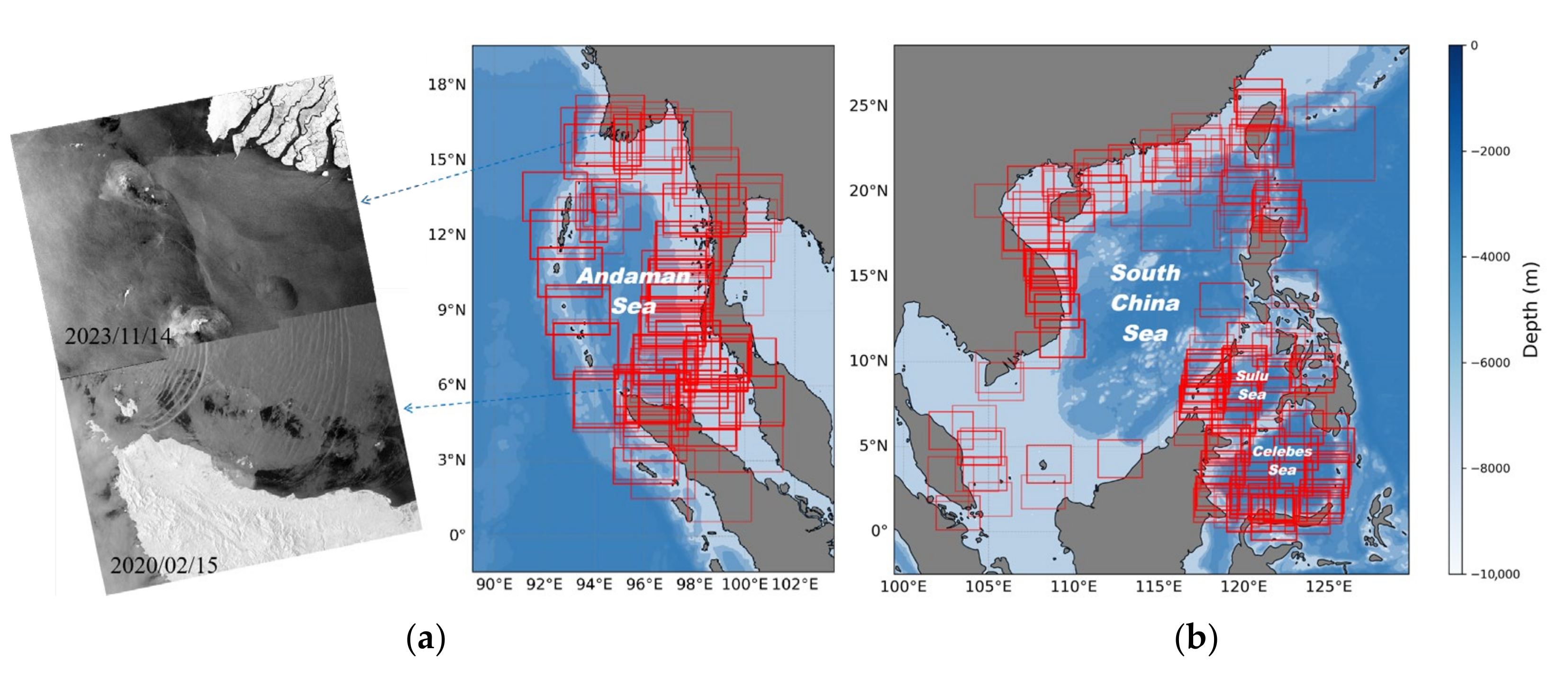
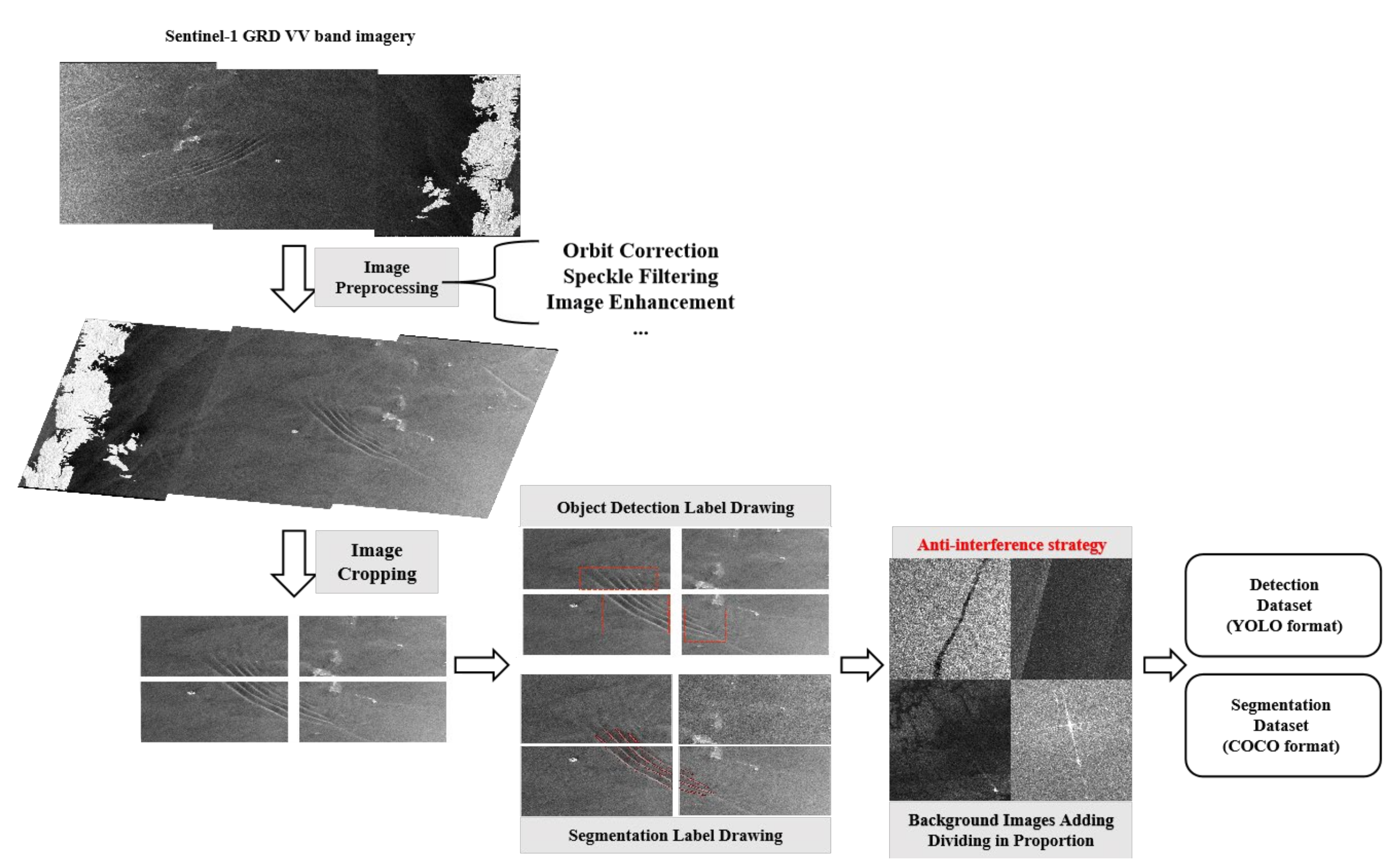


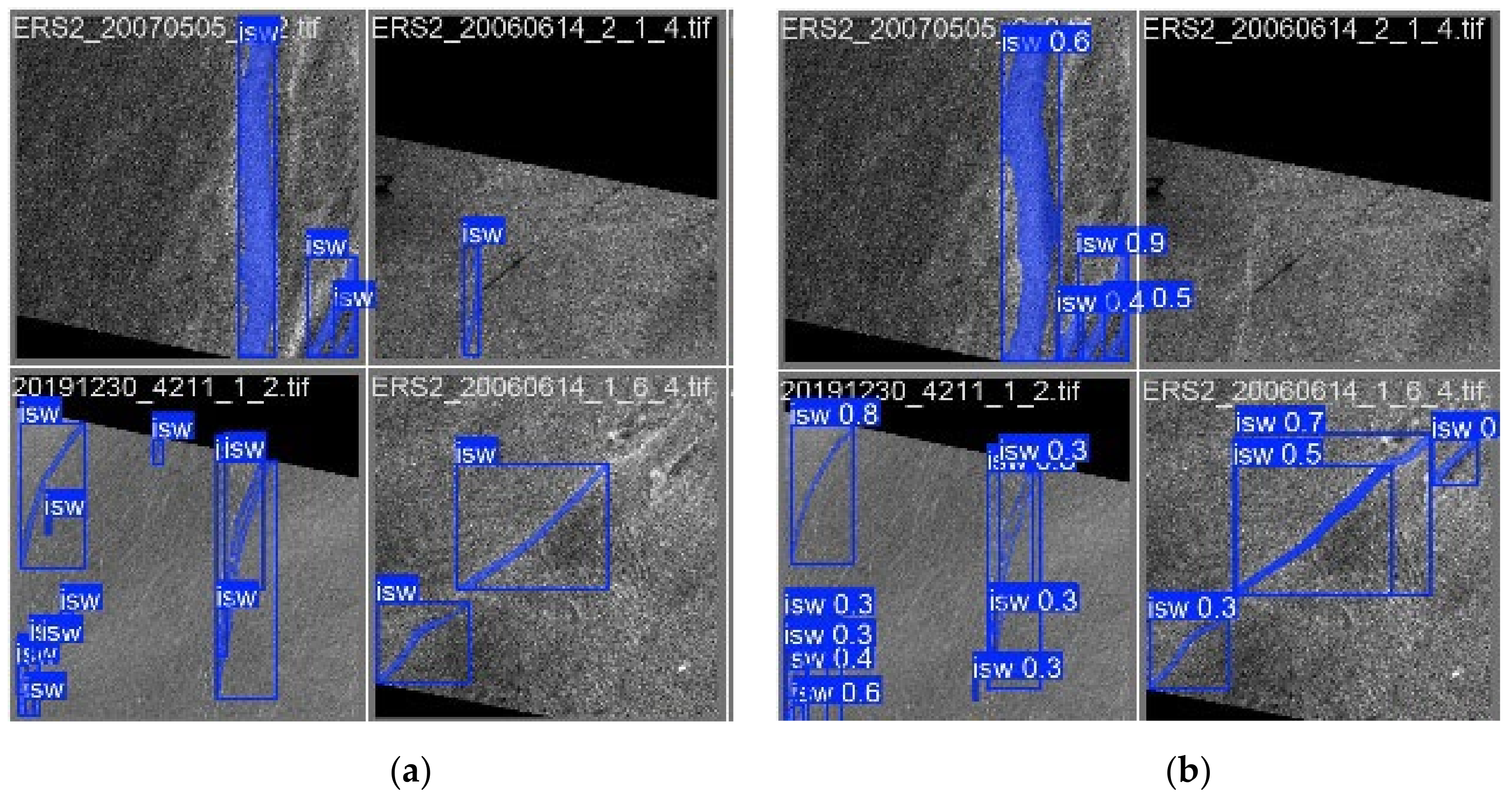
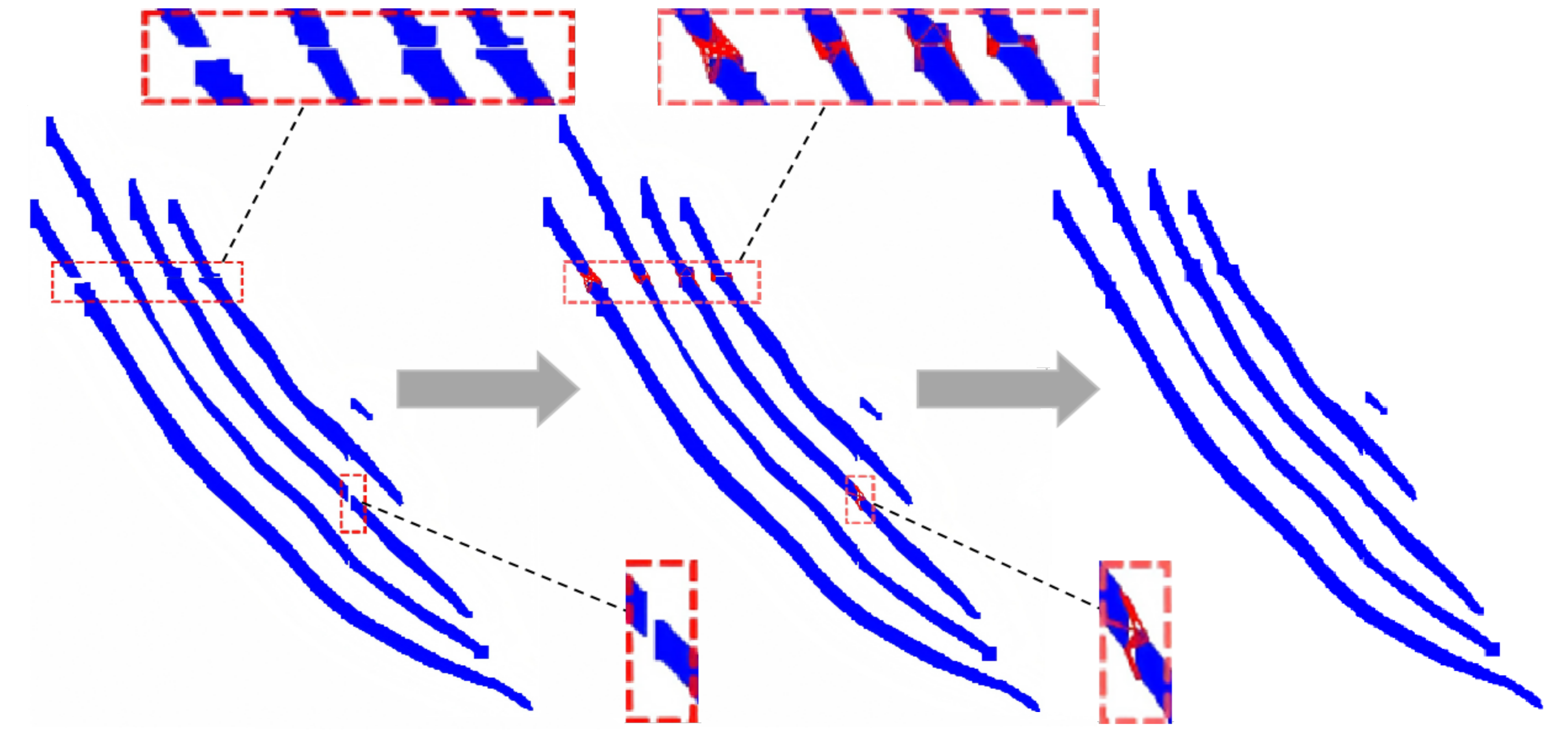

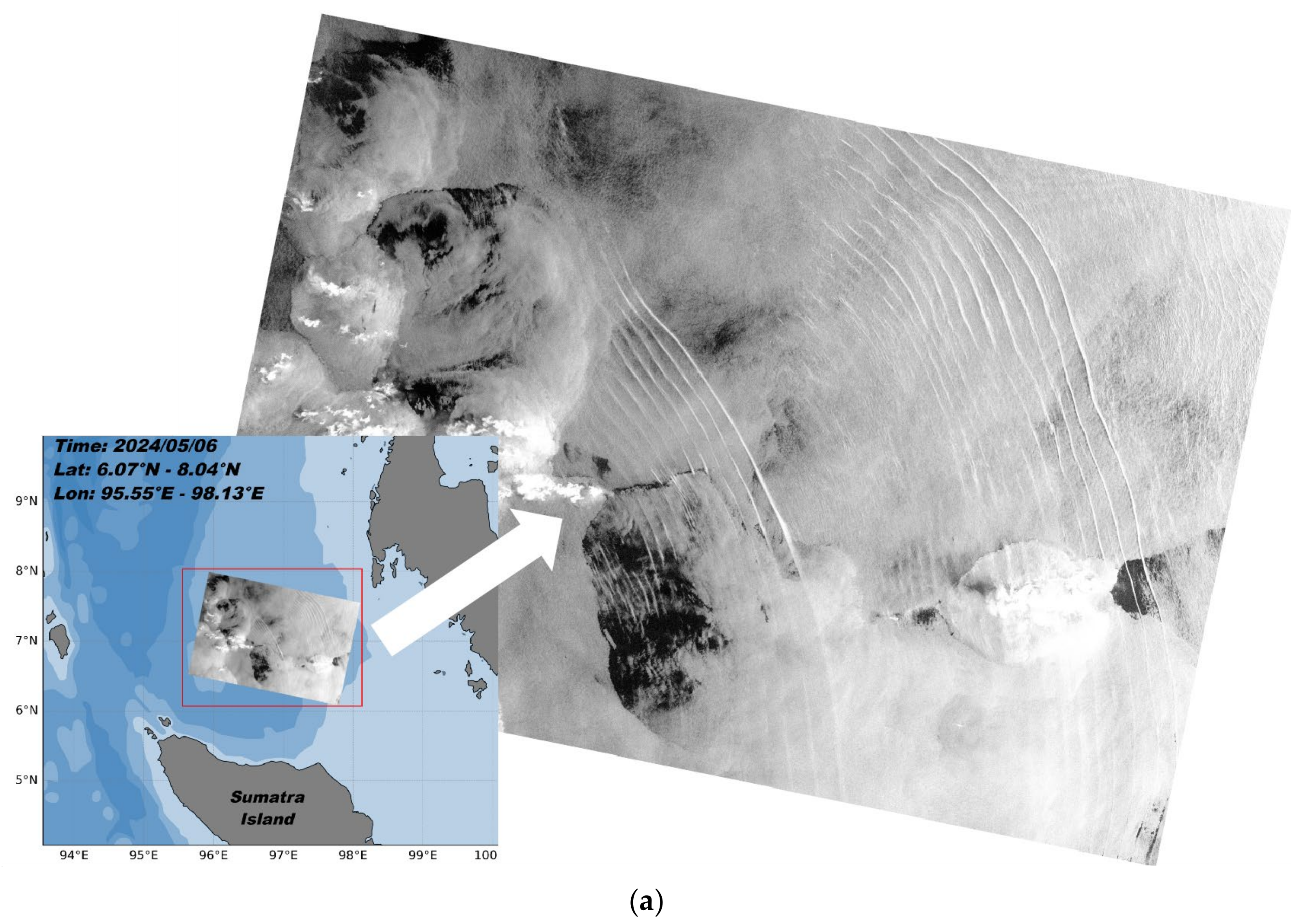
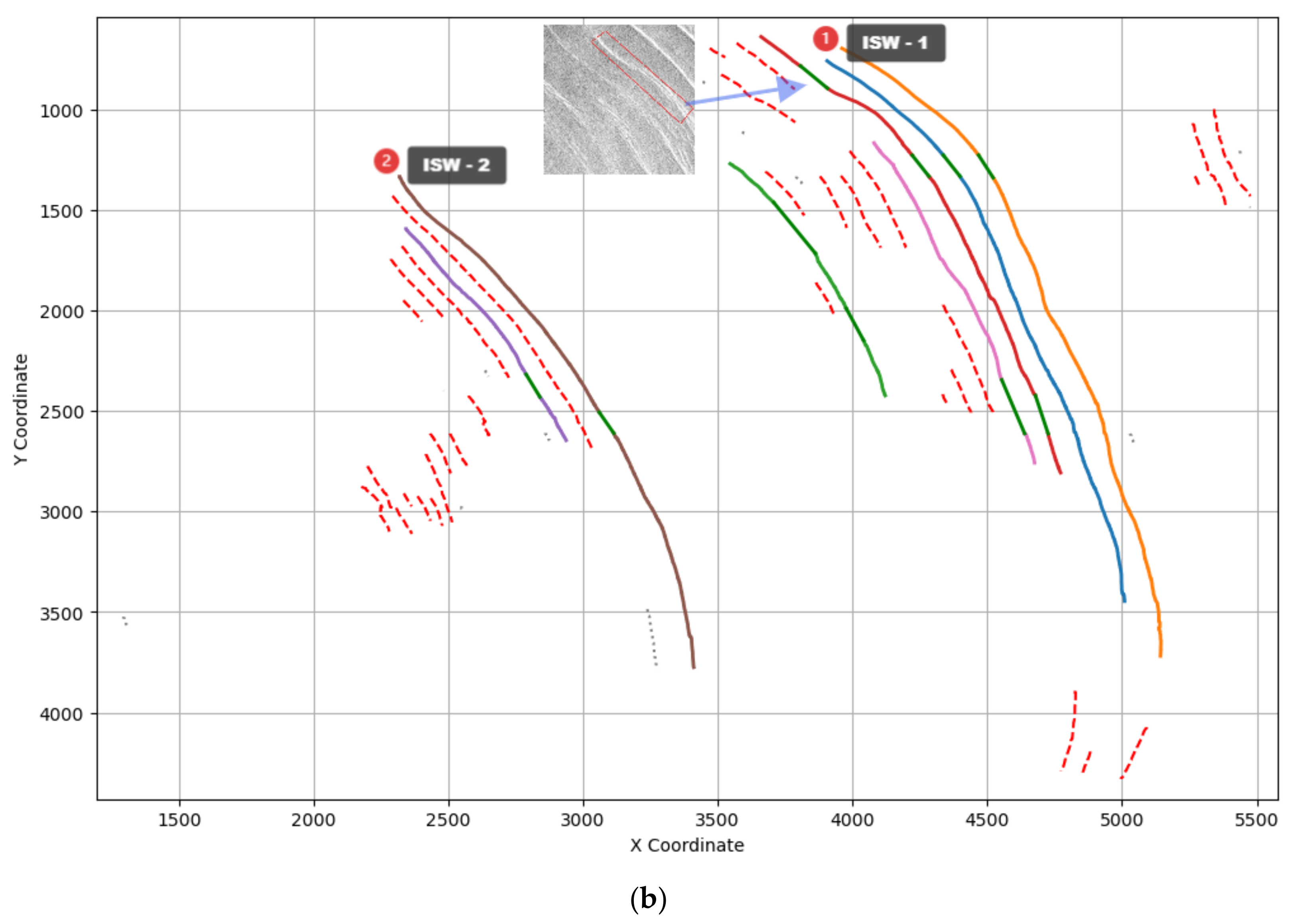

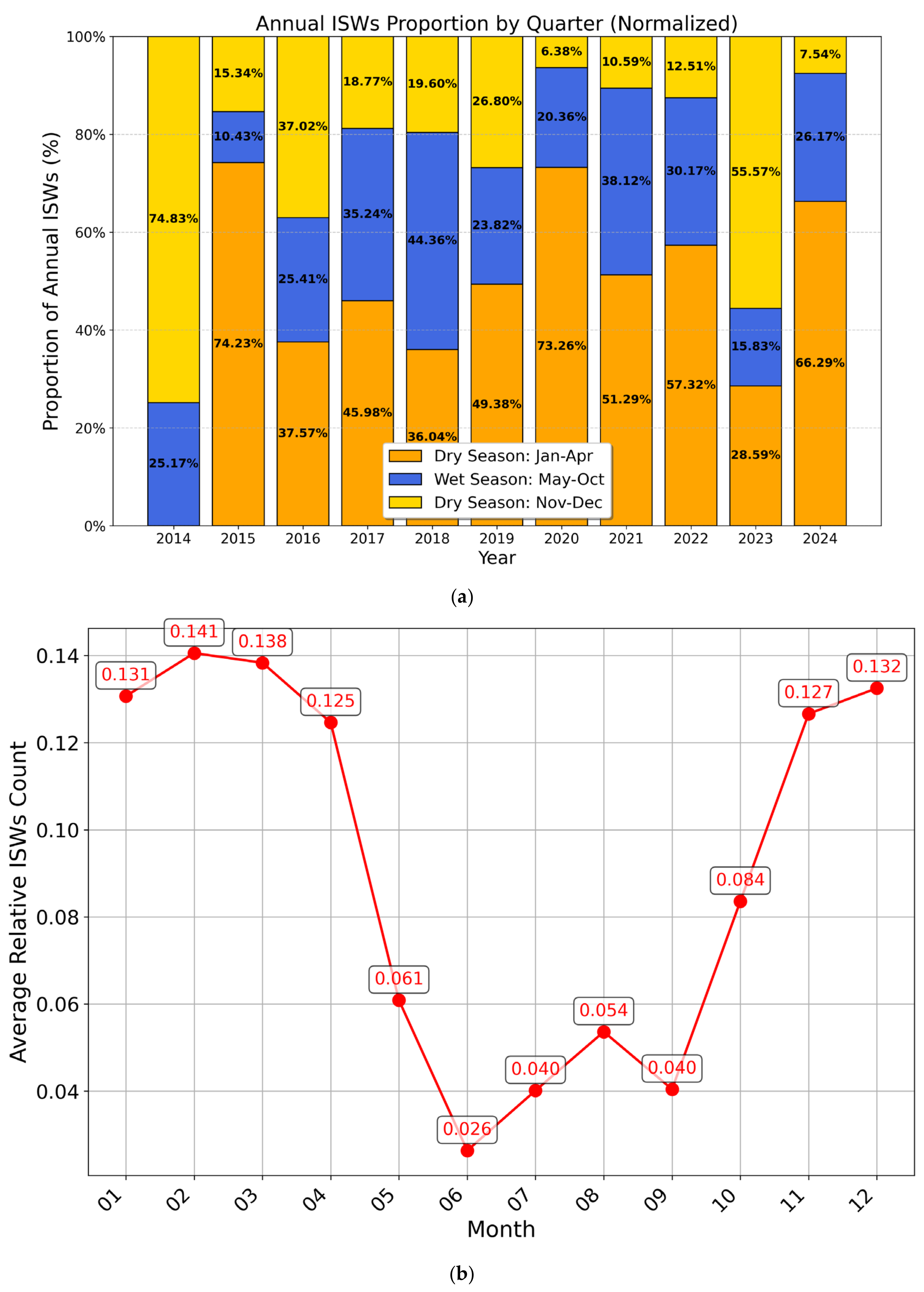
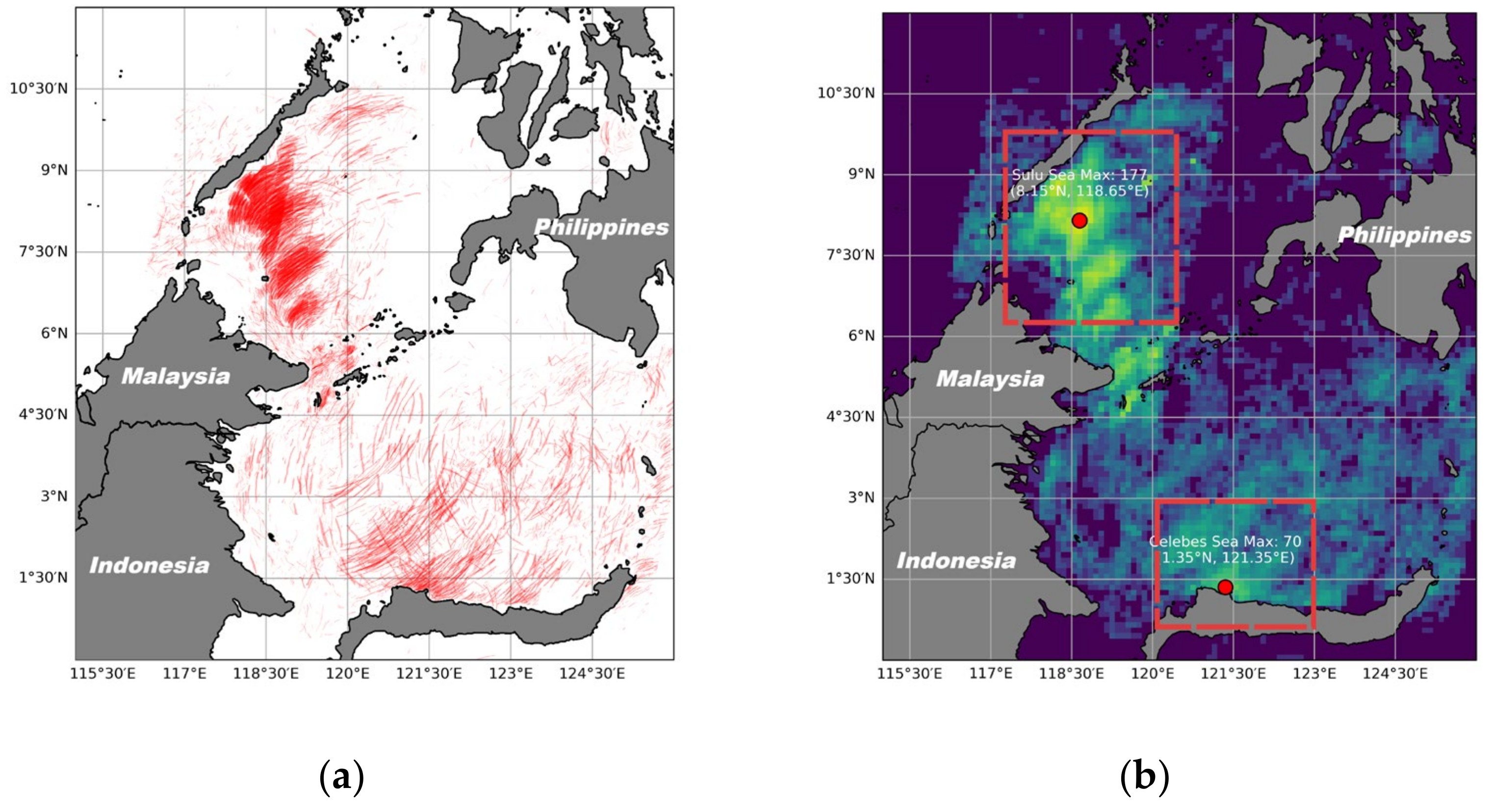

| Types | Sample Size (Cases) | False Detections (Cases) | Error Reduction Rate (%) | |
|---|---|---|---|---|
| Model Without the Anti-Interference Strategy | Model with the Anti-Interference Strategy | |||
| oceanic fronts | 100 | 47 | 3 | 44.00 |
| oil slicks | 100 | 54 | 4 | 50.00 |
| ship wakes | 100 | 48 | 6 | 42.00 |
| vortex edges | 100 | 40 | 4 | 36.00 |
| others | 100 | 62 | 13 | 49.00 |
| Total | 500 | 251 | 30 | 44.20 |
Disclaimer/Publisher’s Note: The statements, opinions and data contained in all publications are solely those of the individual author(s) and contributor(s) and not of MDPI and/or the editor(s). MDPI and/or the editor(s) disclaim responsibility for any injury to people or property resulting from any ideas, methods, instructions or products referred to in the content. |
© 2025 by the authors. Licensee MDPI, Basel, Switzerland. This article is an open access article distributed under the terms and conditions of the Creative Commons Attribution (CC BY) license (https://creativecommons.org/licenses/by/4.0/).
Share and Cite
Lu, Z.; Du, H.; Wang, S.; Wu, J.; Peng, P. An Enhanced SAR-Based ISW Detection Method Using YOLOv8 with an Anti-Interference Strategy and Repair Module and Its Applications. Remote Sens. 2025, 17, 3390. https://doi.org/10.3390/rs17193390
Lu Z, Du H, Wang S, Wu J, Peng P. An Enhanced SAR-Based ISW Detection Method Using YOLOv8 with an Anti-Interference Strategy and Repair Module and Its Applications. Remote Sensing. 2025; 17(19):3390. https://doi.org/10.3390/rs17193390
Chicago/Turabian StyleLu, Zheyu, Hui Du, Shaodong Wang, Jianping Wu, and Pai Peng. 2025. "An Enhanced SAR-Based ISW Detection Method Using YOLOv8 with an Anti-Interference Strategy and Repair Module and Its Applications" Remote Sensing 17, no. 19: 3390. https://doi.org/10.3390/rs17193390
APA StyleLu, Z., Du, H., Wang, S., Wu, J., & Peng, P. (2025). An Enhanced SAR-Based ISW Detection Method Using YOLOv8 with an Anti-Interference Strategy and Repair Module and Its Applications. Remote Sensing, 17(19), 3390. https://doi.org/10.3390/rs17193390






